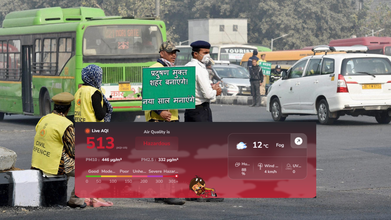- Health Conditions A-Z
- Health & Wellness
- Nutrition
- Fitness
- Health News
- Ayurveda
- Videos
- Medicine A-Z
- Parenting
Leptospirosis Outbreak: Deadly Bacteria Kills 6 People In Jamaica

Credits: Canva
Leptospirosis Outbreak: In the wake of Hurricane Melissa’s destruction, Jamaica is now confronting a second emergency: a surge of leptospirosis cases. Public health authorities confirmed on Friday that six people have died from the bacterial illness, which is commonly spread through water contaminated with rat urine, a major risk after heavy flooding and storm damage.
So far, 37 people are believed to have fallen ill since the Category 5 storm struck on October 28. Although only nine cases have been confirmed through laboratory tests, officials warn that the true number is likely far higher. With widespread power outages, damaged communication lines, and thousands still living amid floodwaters, the country’s health minister, Christopher Tufton, told the New York Times, the extent of infections may remain unknown for weeks.
Hurricane Melissa left behind staggering destruction, 45 lives lost and more than 146,000 structures severely damaged, and the public health consequences are just beginning to unfold.
What Is Leptospirosis and Why It Spreads After Storms
Leptospirosis is caused by Leptospira bacteria found in the urine of infected animals, most commonly rodents. The bacteria thrive in moist environments and can survive for months in wet soil or stagnant water. When storms displace rodents and contaminate floodwaters, the risk of widespread exposure rises sharply.
Mild cases resemble common viral illnesses like flu or dengue, while severe infections can lead to kidney failure, liver damage, or jaundice. Typical symptoms include fever, muscle pain, chills, vomiting and fatigue, making diagnosis difficult without testing.
Leptospirosis is relatively rare in high-income countries, yet even cities like New York have seen rising cases due to rat infestations. After Hurricane Maria devastated Puerto Rico in 2017, the illness killed at least 26 people, a pattern now repeating in Jamaica.
Why Post-Storm Conditions Heighten Risk
Health minister Tufton noted that anyone exposed to flooded streets, muddy fields, or storm debris faces a heightened risk. Farmers, emergency workers, and cleanup volunteers are among the most vulnerable, he said.
“Dead animals would carry the bacteria,” Tufton explained. “It’s very easy to pick up the bacteria while you are doing your regular — or unusual — work of cleanup.”
Flooding also forces rodents out of their burrows, leading them into homes, shelters, and debris piles where they shed bacteria more easily.
Before Hurricane Melissa, Jamaica typically recorded two to 21 cases per month, according to Karen Webster Kerr, the country’s chief epidemiologist. But November alone has already seen about 35 cases, with days still left in the month. Most infections are concentrated around Montego Bay, and a majority of the sick are men — a pattern that aligns with who often undertakes cleanup work.
Everyone Now at Risk — Not Just High-Exposure Workers
Dr. Webster Kerr, as reported by The New York Times, explained that before the storm, leptospirosis was mainly an occupational hazard. Workers on farms or in sewer systems faced the most exposure. But after Melissa, the risk expanded dramatically.
“Now everybody has the likelihood of being exposed,” she said. “Everybody is cleaning up, and a lot of persons are in those waters.”
With many communities still struggling without electricity or cell service, public health outreach has become significantly harder. Teams are attempting early detection and awareness campaigns, warning families not to walk in floodwaters and to wear protective gear whenever possible.
Urgent Call for Supplies and Protective Gear
Alongside food aid, the health minister urged volunteers and relief teams to distribute rubber boots, gloves, and cleaning supplies — items essential for protection but scarce in many areas.
“There are more cases out there than actually detected,” Tufton warned. “It’s like Covid: For every one that’s detected, there may be five or six others in the environment. We can’t treat it lightly.”
Health Experts Stress Continued Vigilance
Ian Stein, the Pan American Health Organization’s representative in Jamaica, praised the government’s quick response and transparency. But he emphasized that information flow in affected regions will be critical for epidemiologists to identify new clusters and predict spread.
“We often focus on a hurricane’s immediate path,” Stein said. “Yet the aftermath can pose equally serious risks, particularly the threat of emerging diseases that tend to follow major storms.”
As families across Jamaica continue clearing debris and navigating unsafe waters, health authorities fear that the leptospirosis outbreak may grow before it subsides, a stark reminder that the danger of hurricanes often lingers long after the winds fade.
Bollywood Legend Dharmendra Dies At 89: Why Respiratory Ailments Are Tougher To Treat In The Elderly

Credits: Dharmendra Deol Instagram
Veteran Bollywood actor Dharmendra passed away on Monday morning in Mumbai at the age of 89, police sources at the cremation ground confirmed. The actor, who had featured in over 300 films across a remarkable career, had been unwell for about a month. His final rites were performed at the Pawan Hans crematorium.
Dharmendra was just weeks away from his 90th birthday on December 8. He had been hospitalised in October for breathlessness, placed on ventilator support, and discharged on November 12. He passed away at his home in Mumbai on November 24, 2025.
Dharmendra Passes Away At 89
Legendary actor Dharmendra has passed away at 89. Fondly remembered as the 'He-Man' of Indian cinema, he leaves behind a career spanning over six decades and more than 300 films. The country mourns an icon who shaped an era of Hindi cinema. While the official cause of death has not been formally announced, sources close to the family indicate that his passing was linked to long-standing age-related health issues.
In the past weeks, Dharmendra had been hospitalised multiple times for respiratory problems, including a stay at Mumbai’s Breach Candy Hospital in early November.
Reports suggest he was on ventilator support for some time and later discharged to continue treatment at home. Age-related complications, including breathing difficulties, appear to have played a role in his declining health.
Why Respiratory Ailments Are Tougher To Treat In The Elderly?
As reports suggest Dharmendra passed away due to respiratory issues, it is important to understand why such illnesses are harder to manage in older adults. According to the National Institutes of Health, respiratory ailments are challenging to treat in the elderly because of a mix of physical changes in the lungs and chest wall, a weakened immune system, multiple pre-existing health conditions, and difficulties in diagnosis and treatment delivery.
Decreased Lung Elasticity and Function: With age, the lungs lose flexibility and the chest wall stiffens, making breathing harder and reducing total lung capacity. This limits the oxygen entering the bloodstream and slows the removal of carbon dioxide.
Weakened Respiratory Muscles: Muscles like the diaphragm and intercostals lose strength, reducing the ability to take deep breaths or cough effectively. This allows mucus and germs to accumulate in the lungs, raising the risk of infections such as pneumonia.
Impaired Gas Exchange: Tiny air sacs (alveoli) lose their shape and efficiency, decreasing the surface area for oxygen and carbon dioxide exchange.
Diminished Protective Reflexes: Nerve sensitivity in the airways declines, weakening the cough reflex and making it harder to clear germs and particles from the lungs.
Moreover, as Dharmendra had been on a ventilator, studies published in BMC Geriatrics and the JAMA Network show that elderly patients requiring invasive mechanical ventilation face significantly higher mortality rates, nearly 90% for those aged 80 and above. Experts explain that age-related frailty, existing health conditions, and the invasive nature of ventilation all reduce chances of recovery.
Older age, pre-existing illnesses, and the need for ventilator support together contribute to poor outcomes. Simply put, the combination of advanced age and ventilator use is strongly linked to lower survival chances. This highlights the importance of raising awareness about liver and respiratory conditions, particularly in older adults, to ensure timely treatment and improved health outcomes.
Delhi Pollution Is A Major Health Hazard, Toxic Air Could Even Cause Organ Damage, According To Doctors

Credits: PTI and Aqi.in
As of 8am, in Delhi, the city's average AQI stands at 513 according to aqi.in. Major pollutant in the Delhi's air include PM2.5, PM10, Carbon Monoxide, Sulfur Dioxide, Nitrogen Dioxide, and Ozone. The AQI is equivalent to smoking 11.8 cigarettes per day, 82.6 cigarettes per week, and 354 cigarettes in a month. Amid this, doctors have called this major public health hazard, and warned people about the damage it can cause to our organs.
"The smaller the particle the more dangerous it is because it really goes into the depth of our lungs and causes damage there," says Dr. Vivek Nangia, Vice Chairman and Head of Pulmonology at Max Healthcare Saket, as told to news agency PTI.
Speaking to news agency ANI, Dr. Naresh Trehan, MD, Medanta, called the current situation “a major, major health-wise hazard,” stressing that the impact is unfolding across all age groups.
“A disaster for humanity,” says Dr Trehan
According to Dr. Trehan, pollution is now causing illness “many fold,” with outpatient departments packed with people suffering from cough, cold, chest congestion, asthma attacks, and severe breathing difficulties. But his biggest concern goes beyond the lungs.
He explained that the particulate matter present in polluted air moves far deeper into the body than most people realise. “These particulates go everywhere,” he told ANI. “They get absorbed into the blood, they go to your brain, they go to your kidneys, they go to your liver.”
Dr. Trehan added that the chronic effects of such constant exposure are making the public “sicker than they would be if they were living in a cleaner area.” Children, he warned, face an even greater threat as trapped toxic gases and particulate matter during winter behave “like a gas chamber,” potentially harming neurological development.
Dr Nangia breaks down the danger of PM2.5
Giving the scientific context behind this damage, Dr Nangia told PTI that the toxicity varies by particle size.
Particles larger than 5–10 microns usually stay in the upper respiratory tract, causing symptoms like throat irritation, watery eyes, and a runny nose. However, “a particle size less than 2.5 microns goes into the lungs,” he explained. Even more dangerous are particles smaller than 0.5 microns, which “go directly into the bloodstream from the lungs and trigger an inflammatory cascade.”
This cascade, Dr. Nangia said, spreads through the body and can inflame various organs—contributing to asthma, heart disease, high blood pressure, and even conditions like rheumatoid arthritis.
Reading Delhi's AQI
As per the aqi.in there are six categories under which air pollution levels are measured, which are as followed:
- Good 0 to 50
- Moderate 50 to 100
- Poor 100 to 150
- Unhealthy 150 to 200
- Severe 200 to 300
- Hazardous 301+
Fact: AQI in Delhi is 1.9 times above than in India
Public Health Emergency
There are many short-term and long-term impact on public health from the constant exposure of air pollution. As per IQAir, in the short-term, people experience irritation in eyes, throat, and nose, along with irregular heartbeats, asthma attacks, coughing, chest tightness, and difficulty breathing.
Prolonged exposure also intensifies these risks and leads to long-term effects such as chronic respiratory illnesses like bronchitis, asthma, and emphysema. Pollutants can also damage lung tissue, increasing the likelihood of lung cancer. Air pollution also leads to an increased risk of heart attacks and strokes and could also be linked to premature death.
David Cameron, Former UK Prime Minister, Has Prostate Cancer

Credits: Wikimedia Commons
Former UK Prime Minister David Cameron revealed his prostate cancer diagnosis and has called for a targeted screening. In an interview with Times, he said, "You always hope for the best. You have a high PSA score - that is probably nothing. You have an MRI scan with a few black marks on it. You think, ‘Ah, that’s probably OK.’ But when the biopsy comes back, and it says you have got prostate cancer. You always dread hearing those words. And then literally as they’re coming out of the doctor’s mouth you’re thinking, ‘Oh, no, he’s going to say it. He’s going to say it. Oh God, he said it.’"
The former PM, 59, said that he had a prostate-specific antigen (PSA) test for the screening that looks for proteins associated with the form of the disease. His result was high, and a biopsy after that revealed his cancer.
It was his wife, Samantha, who urged him to get tested, after the couple heard the founder of Soho House, Nick Jones, talking about his diagnosis on radio. Cameron had received focal therapy for treatment, where electrical pulses target and destroy the cancer cells.
Cameron Calls for National Prostate Cancer Screening
He has urged the government to introduce a national screening programme to detect prostate cancer earlier, when treatment is far more effective.
Cameron said, “I want to, as it were, come out. I want to add my name to the long list of people calling for a targeted screening programme.
“I don’t particularly like discussing my personal intimate health issues, but I feel I ought to. Let’s be honest. Men are not very good at talking about their health. We tend to put things off.”
Prostate Cancer: The UK’s Most Common Male Cancer
Prostate cancer remains the most common cancer among men in the UK, with around 55,000 cases diagnosed every year. Despite this, there is currently no national screening programme because of concerns over the accuracy of PSA tests.
In October 2024, six-time Olympic gold medallist Chris Hoy revealed he had been diagnosed with terminal stage 4 cancer. His prostate cancer had spread to his shoulder, pelvis, hips, ribs and spine.
Read: Olympic Cyclist Sir Chris Hoy Shares His Diagnosis Of Prostate Cancer From A Common Shoulder Pain
Cameron, who stepped down as prime minister and MP in 2016, returned to government as foreign secretary under Rishi Sunak in 2023 and was appointed a life peer in the House of Lords.
New Screening Trial Begins Across the UK
Cameron’s announcement comes just days after eligible men began receiving invitations to join a major trial testing the most promising prostate cancer screening technologies.
The Transform project will evaluate new screening methods against current NHS diagnostic pathways, which typically include blood tests and biopsies. The trial is being run in partnership with the NHS through the National Institute for Health and Care Research, which has committed £16 million, with additional funding from Prostate Cancer UK.
Its launch coincides with the UK National Screening Committee’s upcoming decision on whether current evidence supports introducing national screening.
‘Men’s Lives Should Not Be Left to Chance’
Chiara De Biase, director of health services, equity and improvement at Prostate Cancer UK, welcomed Cameron’s openness about his diagnosis.
Also Read: Joe Biden Is Diagnosed With Aggressive Prostate Cancer: All That You Need To Know
“We’re glad to hear that David Cameron found his prostate cancer at an early stage and had successful treatment,” she said. “We thank him for sharing his story and raising vital awareness of this disease, which is completely curable if found early. But men’s lives should not be left to chance.
“We lose 12,000 dads, brothers, sons and friends every year. We’ve reached a tipping point in the UK, with too many men dying from a curable disease and worse outcomes for higher-risk groups like black men and men from working-class communities.
“Prostate cancer is the last major cancer without a screening programme, and we need change now.”
What Happens In Prostate Cancer?
As per Urology Care Foundation, prostate cancer develops when abnormal cells form and grow in the prostate gland. Not all abnormal growths, also called tumors, are cancerous. Some are benign growth and are not life threatening. They also do not spread to nearby tissue or other parts of the body.
Whereas cancerous growths can spread to nearby organs and tissues, as in the case of Biden.
© 2024 Bennett, Coleman & Company Limited

